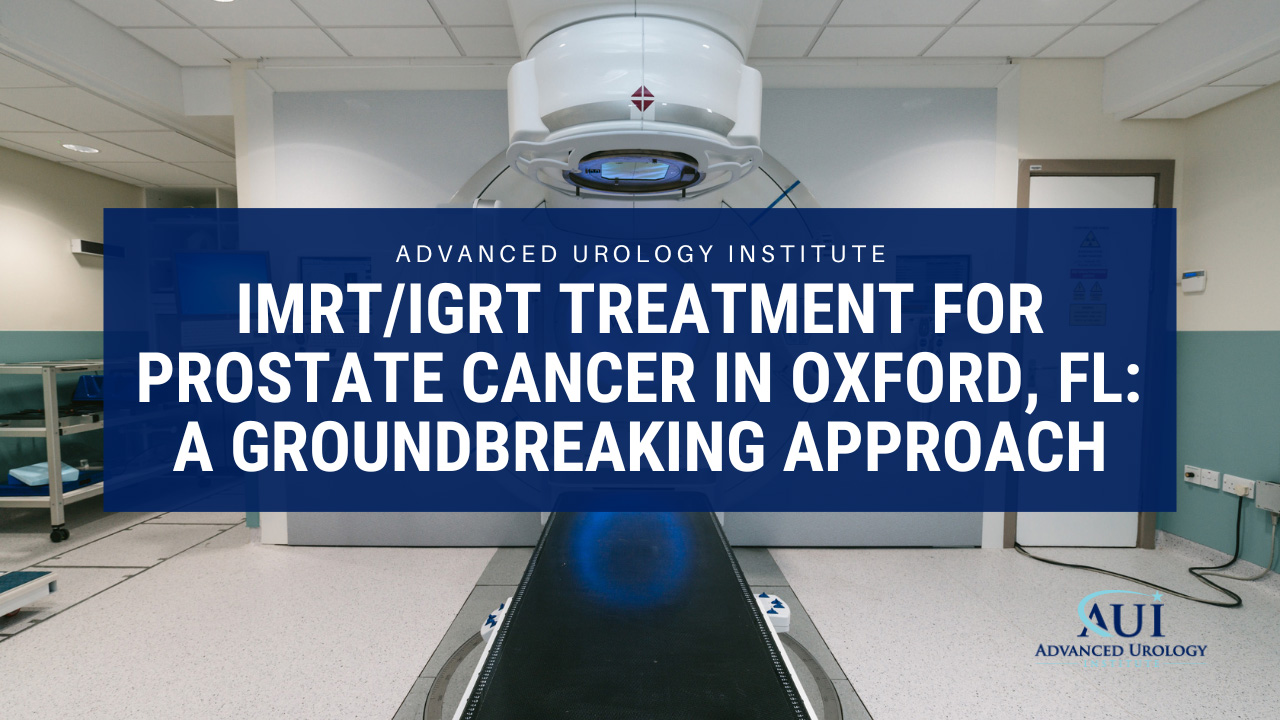IMRT/IGRT Treatment for Prostate Cancer in Oxford, FL: A Groundbreaking Approach
3 Key Takeaways:
- IMRT/IGRT is a method of prostate cancer treatment recognized by leading professionals that is recommended over the use of protons.
- Photon treatment, used by the Advanced Urology Institute, is an effective and highly precise form of treatment that minimizes negative side effects.
- The Advanced Urology Institute offers a patient-centered approach that sets them apart from other prostate cancer treatment centers.
https://www.youtube.com/watch?v=uVCeq6FxNtI
 As you navigate the journey of prostate cancer treatment in Oxford, Florida, it’s essential to be aware of the different approaches available to you. Among these is the Intensity-Modulated Radiation Therapy (IMRT) and Image-Guided Radiation Therapy (IGRT), a method recognized by leading professionals in radiation physics, such as Don Dubois, PhD. This article provides insights into why this therapy is recommended over other modalities, such as the use of protons.
As you navigate the journey of prostate cancer treatment in Oxford, Florida, it’s essential to be aware of the different approaches available to you. Among these is the Intensity-Modulated Radiation Therapy (IMRT) and Image-Guided Radiation Therapy (IGRT), a method recognized by leading professionals in radiation physics, such as Don Dubois, PhD. This article provides insights into why this therapy is recommended over other modalities, such as the use of protons.
Finding the Right Tool for Prostate Cancer Treatment
“Every time a new technology comes out, people are real excited about it,” Dubois remarks, highlighting the importance of understanding what each type of treatment entails. His stance on proton therapy is that while it’s “absolutely fantastic” for treating specific types of cancers, like pediatric brain cancers, “it’s probably not the optimal tool to use in treating prostate cancer.”
The reason for this, Dubois explains, has to do with how protons distribute within the body. Essentially, to make sure they hit the target (the prostate), they end up treating more of the normal and critical structures in the body. The risk, however, is that if they don’t treat enough, they may miss the target entirely, potentially risking a recurrence of cancer.
Cutting-Edge Photon Treatment
“The method that we’ve chosen to implement here”, as Dubois states, is photons treatment. It’s an excellent example of fine-tuned technology, specifically designed to achieve the best possible outcomes for prostate cancer patients while minimizing negative side effects.
There are many scientific papers supporting his point. As he indicates, “There are many papers published basically stating that proton therapy does no better and in some cases, it’s worse than treating with photons”.
The Advanced Urology Institute Difference
When it comes to prostate cancer treatment in Oxford, FL, the decision-making process can be overwhelming. As one patient rightly said, “Prostate cancer, there were many, many options, very, very confusing as to know which direction to go”.
This is where the Advanced Urology Institute comes in. As the largest urology practice in Florida, AUI is at the forefront of providing high-quality care for prostate cancer patients. Their team includes esteemed professionals like Dr. Don Dubois, dedicated to offering the most effective treatments and aiding patients in navigating their options.
The institute is steadfast in its choice to implement photon treatment over protons, thus focusing on strategies that best serve the needs of prostate cancer patients. This patient-centered approach sets AUI apart and makes them a sought-after destination for those seeking prostate cancer treatment in Florida.
Remember, while there’s no one-size-fits-all solution in cancer treatment, relying on the expertise and guidance of top-notch institutions like Advanced Urology Institute can make a world of difference in your journey towards recovery.
References:
- “Intensity-Modulated Radiation Therapy (IMRT) – RadiologyInfo.org.” https://www.radiologyinfo.org/en/info/imrt.
- “What Is Image-Guided Radiation Therapy (IGRT)?.” https://www.mskcc.org/cancer-care/diagnosis-treatment/cancer-treatments/radiation-therapy/what-igrt.
- “What Are The Side Effects Of Prostate Cancer Treatment?.” https://www.pcf.org/about-prostate-cancer/prostate-cancer-side-effects/.
Transcription:
Every time a new technology comes out, people are real excited about it, and it sometimes becomes a hammer and nail syndrome. In other words, they have this fantastic tool and they want to apply it to everything. Protons are fantastic for certain types of treatments, specifically in my mind they’re absolutely fantastic and the way to go in treating things like pediatric cancers within the brain. Unfortunately, they’ve tried to apply that modality to prostates as well, and if you understand how protons distribute within the body, you have to understand that basically what they end up doing is treating a little bit more of the normal and the critical structures in order to ensure that they’re actually hitting the target, the prostate. And if they don’t treat more of it well, then there’s a strong possibility that they’re actually missing the target, which is obviously a no-brainer. You don’t want to miss the target and risk having a recurrence of the cancer. So, in a nutshell, it’s probably not the optimal tool to use in treating prostate cancer. There are many papers published basically stating that it does no better and in some cases it’s worse than treating with photons, which is the method that we’ve chosen to implement here.
Prostate cancer, there were many, many options, very, very confusing as to know which direction to go, but my son does research.

